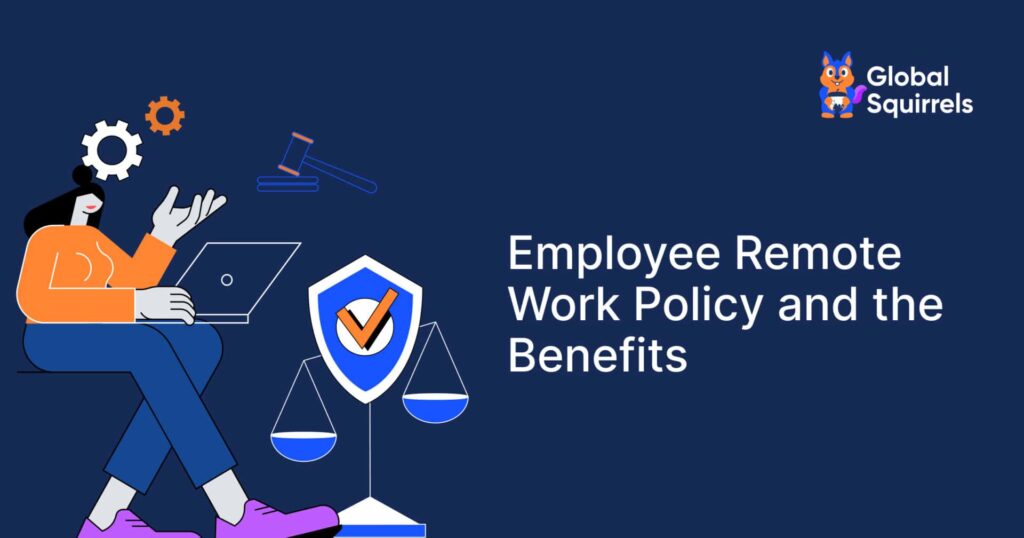Employee remote work policy and benefits

In IT, finance, and management industries, remote or work-from-home options have risen. Therefore, companies need remote work guidelines to align the remote employees with the company’s work culture. With the advancement of cloud applications and other devices, professionals can connect globally.
So, to implement remote work practices in your organization, you need to know the best practices for managing remote employees.
In this blog, we will discuss remote work policy and the benefits of these practices.
Every company has its own internal policy, international or national, and so does the remote policy. The guiding rules must vary from company to company, even the country. However, the standard rules are the same for all organizations.
Here is the discussion about national and international employee remote work policies, which are applicable irrespective of company size, volume, and industry.
What is the remote work policy?
A remote work policy is a set of guidelines and policies established by an organization to govern how remote work is conducted within the company. It outlines remote employees’ expectations, responsibilities, and procedures, whether partially or fully. A well-defined remote work policy typically covers all the necessary workforce management aspects.
Remote work guidelines: A glimpse
A well-defined remote work policy establishes clear expectations, promotes trust, and ensures productivity for companies and employees. Here are comprehensive guidelines to help you craft your remote work policy:
Eligibility:
- Define eligible roles: When determining which roles qualify for remote work, consider job responsibilities, data security, and communication needs.
- Performance evaluation: Link eligibility to performance metrics and conduct periodic reviews to maintain high standards. It will boost employees’ productivity.
Technology and equipment:
- Minimum requirements: Specify minimum internet speed and hardware and software requirements to ensure efficient work performance.
- Company provision: Decide whether the company will provide equipment or if employees will self-fund.
- Security measures: Outline data security protocols, including encrypted connections, password management, and software updates.
Communication and collaboration:
- Preferred communication channels: Establish clear guidelines for preferred communication methods (email, instant messaging, video conferencing) based on context and urgency.
- Meeting schedules and availability: Define core working hours and set expectations for communication availability and response times.
- Collaboration tools: Specify approved collaboration tools and platforms to facilitate teamwork and information sharing.
Performance management and productivity:
- Clear performance expectations: Clearly define remote employees’ performance goals and evaluation criteria.
- Regular feedback and check-ins: Implement regular performance check-ins and feedback loops to address concerns and maintain accountability.
- Tracking and monitoring: Define acceptable methods for tracking work hours and ensuring task completion without being overly intrusive.
Data security and privacy:
- Data access and usage: Clearly outline acceptable data access permissions, usage limitations, and procedures for handling sensitive information remotely.
- Disaster recovery: Establish a data backup and recovery plan to protect against data loss or breaches in the remote work environment.
- Confidentiality and compliance: Ensure adherence to all relevant data privacy and security regulations, including industry-specific compliance requirements.
Work-life balance and wellbeing:
- Right to disconnect: Encourage employees to take breaks and avoid working excessive hours to maintain healthy work-life boundaries.
- Access to support: Provide resources and support systems for mental health and well-being, recognizing the unique challenges of remote work.
Review and revision:
- Regular review and updates: Periodically review and update the policy to adapt to changing needs and circumstances.
- Employee feedback: Encourage feedback from employees to ensure the policy reflects their concerns and promotes a positive remote work experience.
- Transparency and communication: Communicate the policy to all employees and make it readily accessible for reference.
Additional considerations:
- Legal and regulatory compliance: Ensure the policy aligns with all relevant labor laws, tax rules, and industry standards.
- Cultural sensitivity: When developing the policy, consider cultural differences and communication styles, especially if your workforce is geographically diverse.
- Trial period and training: Implement a trial period to test the policy in practice and offer training on expectations and best practices for remote work.
A well-crafted remote work policy is a flexible document tailored to your company’s culture, workforce needs, and industry context.
Also Read: International Remote Work Guide for Employers and Employees
Remote work benefits for employers
Implementing an international employee remote work policy can benefit companies and employees. Here are some key advantages:
1. Access to a broader talent pool:
Attract and retain top talent despite location, expanding your talent pool and fostering diversity in your workforce.
2. Reduced costs:
Save on office space, overhead expenses, and employee relocation costs.
3. Increased productivity and employee satisfaction:
With homestay benefits, remote workers can be just as productive, sometimes even more, and generally report higher satisfaction due to improved work-life balance.
4. Improved talent retention:
Remote work options can help employee retention, especially among younger generations that value flexibility.
5. Enhanced global collaboration:
Nurture a more collaborative and inclusive work environment, facilitating communication and knowledge sharing across international teams.
6. Improved disaster preparedness:
A remote workforce can continue operations despite local disruptions like natural disasters or pandemics.
The primary benefits emphasized global talent accessibility and cost-effectiveness. Irrespective of the company’s business domain, you can implement remote work practices for better hiring and save precious time and funds.
Further, with the advent of technology, software, tools, and applications, you can better manage your remote employees regardless of their locations.
Global Squirrels-like platform assists you in managing your remote employees effectively despite you staying wherever you are on this earth.
Global Squirrels: best platform to manage remote employees
You need a solution for the best practices for managing remote employees that Global Squirrels serve. The platform helps you to find the right employees.
Besides finding talent, the platform helps in payroll management, including payroll calculations, benefits, leaves, attendance sheets, compliance based on international laws, and many more.
You can talk to our expert and plan your remote work guidelines for effective team management.
Conclusion
An international employee remote work policy is essential for business owners to manage their remote workforce efficiently. As distance is squeezed due to technological advancement, the practice brings many benefits that help organizations flourish. Additionally, sign up with Global Squirrels and manage your global employees easily.

